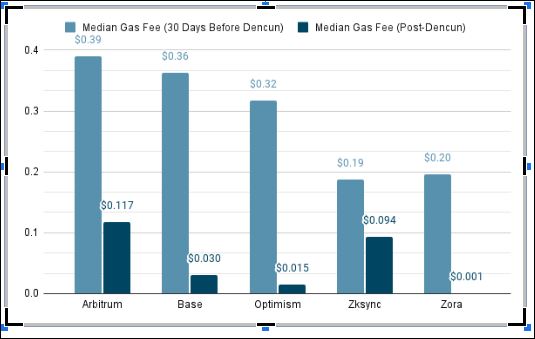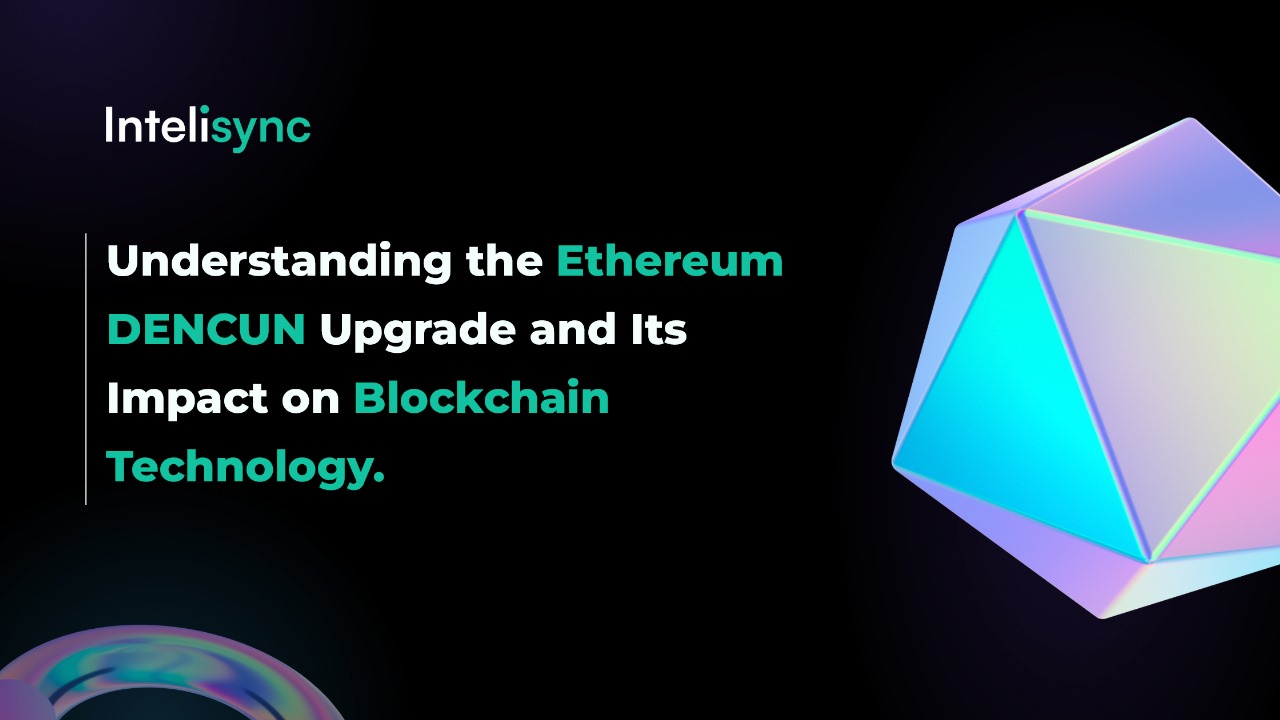What is Ethereum DENCUN upgrade
March 13 was a pivotal day for Ethereum and its ecosystem. On March 13, 2024, the Ethereum blockchain implemented the DENCUN upgrade, incorporating EIP4844. The community members, filled with anxiety, excitement, and anticipation, had been buzzing in the buildup to this significant event.
This fervor was entirely justified, as the world’s second-largest blockchain, in terms of stored value, underwent a major transformation.
The upgrade, finalized at during Ethereum epoch 269,568, marked a crucial step towards scalability and initiated the blockchain’s transformation onto a new path.
Following this the transaction fees across major layer 2 blockchains and roll ups fell overnight by more than 50%.
Making transacting on these chains cheaper and more accessible. This article delves into the essence of the DENCUN upgrade, examining its necessity, its components like blobs, and its long-term implications for Ethereum, developers, and blockchain-based products.
| L2 | Median Gas Fee (30 Days Before Dencun) | Median Gas Fee (Post-Dencun) | Difference |
| Arbitrum | $0.390 | $0.117 | -70.1% |
| Base | $0.363 | $0.030 | -91.9% |
| Optimism | $0.317 | $0.015 | -95.2% |
| Zksync | $0.187 | $0.094 | -49.5% |
| Zora | $0.196 | $0.001 | -99.6% |

Key Takeaways:
- Major Ethereum Upgrade: The DENCUN upgrade with EIP-4844, implemented on March 13, 2024, significantly enhances Ethereum’s scalability and efficiency by introducing proto-dank sharding and blobs.
- Reduced Transaction Fees: Post-upgrade, transaction fees on Layer 2 blockchains and rollups dropped by over 50%, making Ethereum transactions cheaper and more accessible.
- Boost for dApps: The use of blobs consolidates transactions into single packages, slashing data processing needs on the main chain and elevating scalability and cost-effectiveness for decentralized applications.
- Future of Ethereum: This upgrade is a critical step towards full sharding, promising further scalability improvements and potentially solidifying Ethereum’s position as the leading blockchain development platform, poised to attract even more innovation and investment.
Let’s Dive in!
The Ethereum network upgrades itself in packages that implement multiple EIPs (Ethereum Improvement Proposals). The introduction of EIP-4844, alongside many other EIPs, marks this upgrade. It marks a pivotal moment in Ethereum’s evolution, focusing on scalability, efficiency, and reduced transaction fees, particularly for Layer 2 rollups.
Geeky Version
The Necessity of the DENCUN Upgrade
Ethereum has long grappled with scalability issues as it strives to support a growing number of decentralized applications (dApps), smart contracts, and transactions. The network’s capacity limitations often led to high gas fees and slower transaction times, especially during peak usage. The DENCUN upgrade, with EIP-4844 at its core, addresses these challenges head-on. It introduces mechanisms designed to enhance throughput and efficiency while reducing the operational costs for users and developers.
To understand the upgrade and how it solves the problems faced by layer 2’s we need to first understand, Layer 2 Roll-ups.
How does a Layer 2 Rollup work?
Layer 2 roll ups are of 2 types, Zero knowledge validity proof based and optimistic roll ups. Each layer 2 chain has its own validators who facilitate transactions on the chain. The process involves collecting data from these transactions, batching together the data from multiple transactions, and then submitting it to the Main ETH Layer 1 chain, commonly referred to as the mainchain.
The ZK based roll ups submit a proof of validity of their transactions along with the transaction data.
The mainchain stores this data and checks the validity proof. Once accepted by the mainchain, the roll-up considers the transactions settled and proceeds to the next batch.
During this period, the mainchain actively verifies the submitted data from optimistic roll-ups, ensuring that fraudulent transactions are not submitted. It pauses withdrawals for transactions, and users do not receive confirmations until the mainchain completes its verification process.
In case a validator on the mainchain marks certain transactions submitted by the optimistic roll up as fraudulent.
In both of these cases, the network re-executes all transactions on layer 1, meticulously checking for mistakes and dubious transactions. After rectifying any errors, finality is achieved, enabling the withdrawal of funds as transactions are marked confirmed and final.
However, the data submitted by the roll-ups to the mainchain is permanently stored in the blocks, despite serving no further utility after verification. This data occupies valuable and expensive storage space on mainchain blocks.
4844 and Proto-Dank Sharding?
Hold on! It’s about to get nerdy here!
EIP-4844, a key component of the DENCUN upgrade, introduces the concept of “blobs” to the Ethereum blockchain. Blobs are essentially large data packages that can be included in Ethereum blocks. This is a foundational step towards implementing proto-dank sharding, a precursor to full-fledged sharding expected in future upgrades.
Sharding is a process that splits the blockchain into multiple partitions, called shards, to spread the load and increase the network’s capacity to process transactions and store data.
By allowing blobs to be part of transactions, EIP-4844 enables Layer 2 rollups to bundle many transactions into a single blob.
Once the transactions are verified and there are no frauds in submitted transactions, there is no need to permanently store this transaction data on the main chain, as storage space in each block is limited and hence expensive to allot to transaction data.
The blobs are then deleted after a period of 1-3 months after layer 2 updates are done. This process significantly reduces the amount of data that needs to be processed and stored on the Ethereum main chain, leading to lower transaction fees and higher scalability for dApps and smart contracts
Hang in there! We’re almost done. IF you feel you still don’t understand, scroll down to our non geeky Version to understand the gist of it!
Benefits for Layer 2 Rollups and Ethereum’s Long-Term Vision
Layer 2 rollups, which are solutions that process and store transaction data off the main Ethereum chain, stand to benefit immensely from the DENCUN upgrade. With the introduction of blobs, these rollups can operate more efficiently, enabling faster and cheaper transactions for users.
This improvement is crucial for Ethereum’s long-term goal of becoming a more scalable and user-friendly platform for decentralized finance (DeFi), gaming, and other blockchain applications.
Furthermore, the DENCUN upgrade lays important groundwork for Ethereum’s transition to a fully sharded blockchain. This transition is expected to further enhance the network’s scalability, making Ethereum an even more robust platform for developers and users alike.
Wow i guess that sounds great but I don’t think i fully understand?
Too much tech? Don’t worry, We got you convered!

Non-Geeky Version:
Imagine Ethereum is like a huge, busy city with lots of roads (transactions) and buildings (smart contracts). The city is getting very crowded because more and more people want to live there, causing traffic jams and making it expensive for people to move around. To solve this, the city planners (Ethereum developers) came up with a clever idea called “DENCUN” with something special named “blobs” and a fun concept known as “roll-ups.”
What Are Blobs?
Think of blobs as big, magical bags. These bags can hold a lot of letters (data and transactions) at once. Instead of sending a single letter at a time, which takes up a lot of space on the road and makes things slow, we can put lots of letters into one of these big bags. This way, we only need to move the bag, not each letter individually, making it much faster and cheaper to send messages around the city.
How Roll-ups Benefit from Blobs?
Now, roll-ups are like special buses that move around the city. Without blobs, each bus would have to carry many small packages or letters, making trips slow and expensive because they take up a lot of space. But with blobs, we can put all those letters into one big bag and then just put the bag on the bus. This means the bus can carry a lot more at once, making the trip much quicker and cheaper. The bus can now zoom around the city, delivering letters without getting stuck in traffic.
Why Is This Great?
With the help of blobs and roll-ups, our Ethereum city can handle a lot more people and their activities without getting too crowded or too expensive. It’s like having super-fast buses that can carry lots of stuff in an organized way, making everyone’s life easier. This means more people can play games, use apps, and send money without waiting too long or paying too much. And just like in a real city, when things run smoothly, everyone is happier and can do more fun stuff!
In short, blobs help pack lots of transactions into a big bag, making it easier and cheaper to move them around. Roll-ups are like buses that use these bags to efficiently carry transactions across the Ethereum network. This makes everything faster, cheaper, and allows more people to do more things on Ethereum without running into problems. It’s like having a magical solution to keep our big, bustling city running smoothly.
Implications for Developers and Blockchain-Based Products
For developers and businesses building on Ethereum, the DENCUN upgrade represents a significant leap forward. Reduced transaction fees and improved scalability make it more feasible to develop and maintain dApps, especially those requiring high throughput and low latency, think blockchain games, algo trading platforms, etc . This could lead to a proliferation of new and innovative blockchain-based services, from DeFi products to decentralized social media platforms that were previously not feasible to build due to high transaction costs.
Moreover, the upgrade underscores Ethereum’s commitment to addressing its scalability challenges, reinforcing its position as a leading platform for blockchain development. This commitment may attract more developers and enterprises to the Ethereum ecosystem, further diversifying and strengthening the range of applications built on the blockchain.
Conclusion
The DENCUN upgrade, spearheaded by EIP-4844, marks a critical step in Ethereum’s ongoing evolution. By introducing blobs and proto-dank sharding, it lays the foundation for a more scalable, efficient, and cost-effective blockchain. This upgrade not only benefits Layer 2 rollups but also has profound implications for the broader Ethereum ecosystem, including developers, businesses, and end-users. As Ethereum continues to evolve, the DENCUN upgrade will be remembered as a pivotal moment in its quest to build a decentralized, open, and scalable platform for the next generation of blockchain applications.
Impressed? We are too! Can you think of Ideas that are now possible to be implemented after this upgrade? Are you working on something cool? Let us know!
Who are we and how can we help you?
Intelisync WEB3 development and Marketing agency with expertise in navigating these changes helping you to build more efficient, scalable, and cost-effective blockchain products.
By understanding the technical nuances of the upgrade, such as the efficient data packaging provided by blobs and the consequent reduction in transaction costs, our team can optimize the deployment of decentralized applications (dApps). So you can launch cutting-edge projects on Ethereum, from DeFi platforms to blockchain-based games, with improved performance and lower overheads.
Get in touch with us for all your WEB3 marketing and development needs! Subscribe to our newsletter to receive such breakdowns and informative updates straight to your inbox!

One thought on “Ethereum’s DENCUN Upgrade: Transforming Blockchain”